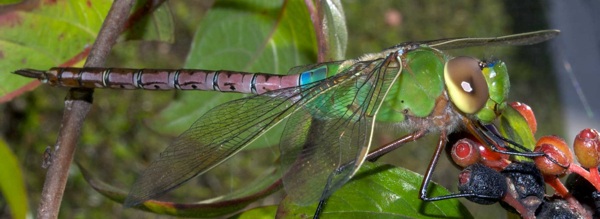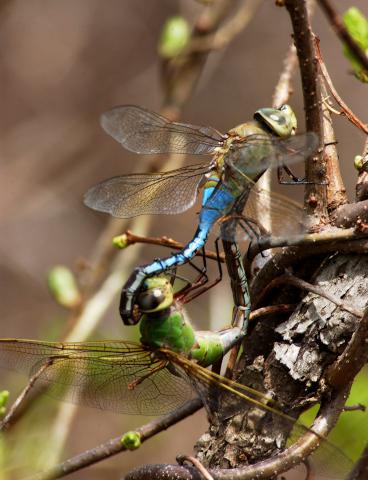
Reproduction
 Anax
junius possess only one set of reproductive organs, either
female or male genitalia. Before mating, the male Anax
junius must transfer his sperm from the tip of his abdomen,
"true genitalia," to the location below his abdomen known as his
"secondary genitalia" (Roach 2001).
A male is then ready to mate and does so by attaching himself to
a female. The male flies next to a female and grabs her behind
the head with his genital claspers, which is located at the tip
of the dragonflies abdomen. The male holds the female in this
manner so the female is unable to escape. The female then
positions herself in a way that allows the tip of her abdomen to
be placed against the males penis and sperm reservoir
(Berger and Hansen 2004). The male
inserts his penis into the females vagina in order to either
remove sperm of a previous mate or to deposit their own sperm
for fertilization to occur (Roach
2001).
Anax
junius possess only one set of reproductive organs, either
female or male genitalia. Before mating, the male Anax
junius must transfer his sperm from the tip of his abdomen,
"true genitalia," to the location below his abdomen known as his
"secondary genitalia" (Roach 2001).
A male is then ready to mate and does so by attaching himself to
a female. The male flies next to a female and grabs her behind
the head with his genital claspers, which is located at the tip
of the dragonflies abdomen. The male holds the female in this
manner so the female is unable to escape. The female then
positions herself in a way that allows the tip of her abdomen to
be placed against the males penis and sperm reservoir
(Berger and Hansen 2004). The male
inserts his penis into the females vagina in order to either
remove sperm of a previous mate or to deposit their own sperm
for fertilization to occur (Roach
2001).
 After
fertilization has occurred, the male will stay attached to the
female until the eggs have been deposited on aquatic vegetation.
The male will stay attached to the female possibly the whole day
to ensure that his sperm is not removed and replaced by a new
mate (Roach 2001). Females search
for a place to deposit their eggs; usually on wood or into
aquatic vegetation. Females use their ovipositors (an organ that
aids in laying eggs) to deposit the eggs into aquatic vegetation
(Marshall 2006). The females
deposit a large amount of offspring to ensure that some will
fully mature into adult dragonflies. The female or the male do
not nurture their offspring after depositing the eggs. The
female deposits her eggs late spring to early summer time. The
offspring hatch roughly 3 weeks later, which either mature right
away (usually occurs in warm water and when nutrients are
plenty) or mature within 4 years (usually occurs in cold water
and when nutrients are scarce)
(Marshall 2006). Offspring usually hatch around August and
September which afterwards, they fly south for the winter. They
return in spring to lay eggs in ponds for the generation to come
(Marshall 2006).
After
fertilization has occurred, the male will stay attached to the
female until the eggs have been deposited on aquatic vegetation.
The male will stay attached to the female possibly the whole day
to ensure that his sperm is not removed and replaced by a new
mate (Roach 2001). Females search
for a place to deposit their eggs; usually on wood or into
aquatic vegetation. Females use their ovipositors (an organ that
aids in laying eggs) to deposit the eggs into aquatic vegetation
(Marshall 2006). The females
deposit a large amount of offspring to ensure that some will
fully mature into adult dragonflies. The female or the male do
not nurture their offspring after depositing the eggs. The
female deposits her eggs late spring to early summer time. The
offspring hatch roughly 3 weeks later, which either mature right
away (usually occurs in warm water and when nutrients are
plenty) or mature within 4 years (usually occurs in cold water
and when nutrients are scarce)
(Marshall 2006). Offspring usually hatch around August and
September which afterwards, they fly south for the winter. They
return in spring to lay eggs in ponds for the generation to come
(Marshall 2006).
For more information about the mating habits and life history of Anax junius, visit the Texas Parks & Wildlife website.
Next explore the Facts of
Anax junius
Return to the Homepage